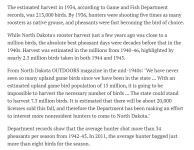You are using an out of date browser. It may not display this or other websites correctly.
You should upgrade or use an alternative browser.
You should upgrade or use an alternative browser.
Question I’ve wondered about
- Thread starter tomt
- Start date
Weimdogman
Well-known member
I have to say I wonder about statistics like bird #'s ,birds harvested ,average hunter?
I know I am not average as I hunt prob 4 days a week and probably harvest 60+ birds myself. Others with me harvest birds also.
I see hunters running from gfp to gfp and never see a bird. I know guys who say they hunt who don't shoot 6 birds a season.
So who did they survey ?
I know I am not average as I hunt prob 4 days a week and probably harvest 60+ birds myself. Others with me harvest birds also.
I see hunters running from gfp to gfp and never see a bird. I know guys who say they hunt who don't shoot 6 birds a season.
So who did they survey ?
thanks for those of you who stuck with the subject and didn’t go into the pen (bad) vs wild (good) conversation. Knowing what worked before is how to plan for the future. I didn’t know about the strategy of planting live chicks in wild bird nests, brilliant!
Looking at the info in the meaningful posts on this thread and the history of pheasant introduction, it seems like it doesn’t take 10’s of thousands of birds, just good habitat and a “few” wild birds that are wily…and some luck with the weather.
So, it already exists that each pheasant state has state land or land owned or leased by their respected wildlife agencies. What if conservation groups and state agencies set aside a few blocks of land in each state to manage for wild upland bird populations without hunting pressure but allowing fur/predator trapping/ deer hunting etc. Then, the excess birds on those properties could be netted and released in areas of states (or neighboring states that would purchase them to cover costs) that need a boast in populations due to drought. The area they were located in would act as a “seed” population for overspill to the surrounding habitat/ county. Kind of like setting up no fish zones in the Oceans, places where birds can reproduce, exceed carrying capacity and radiate outward.
I know, it’s all about habitat and weather, but why not speed up the recovery of places that have the habitat when (and if) the water starts falling again?
Looking at the info in the meaningful posts on this thread and the history of pheasant introduction, it seems like it doesn’t take 10’s of thousands of birds, just good habitat and a “few” wild birds that are wily…and some luck with the weather.
So, it already exists that each pheasant state has state land or land owned or leased by their respected wildlife agencies. What if conservation groups and state agencies set aside a few blocks of land in each state to manage for wild upland bird populations without hunting pressure but allowing fur/predator trapping/ deer hunting etc. Then, the excess birds on those properties could be netted and released in areas of states (or neighboring states that would purchase them to cover costs) that need a boast in populations due to drought. The area they were located in would act as a “seed” population for overspill to the surrounding habitat/ county. Kind of like setting up no fish zones in the Oceans, places where birds can reproduce, exceed carrying capacity and radiate outward.
I know, it’s all about habitat and weather, but why not speed up the recovery of places that have the habitat when (and if) the water starts falling again?
Prairie Drifter
Well-known member
Those early stockings were frequently wild birds or F1 birds out of wild birds. Everywhere there was cropland, the cropland habitat was not what native birds were adapted to. Pheasants thrived in those unoccupied habitats. Some nest predators like raccoons were not prolific at the time as the cavaties and hollow trees were not in existence on the prairie. It's a different world today and the pen-raised birds today have been proven over and again to not increase populations. With the millions of birds released that escape from pay-to-hunt areas survived and reproduced, those stockings would have fixed our population problems.

